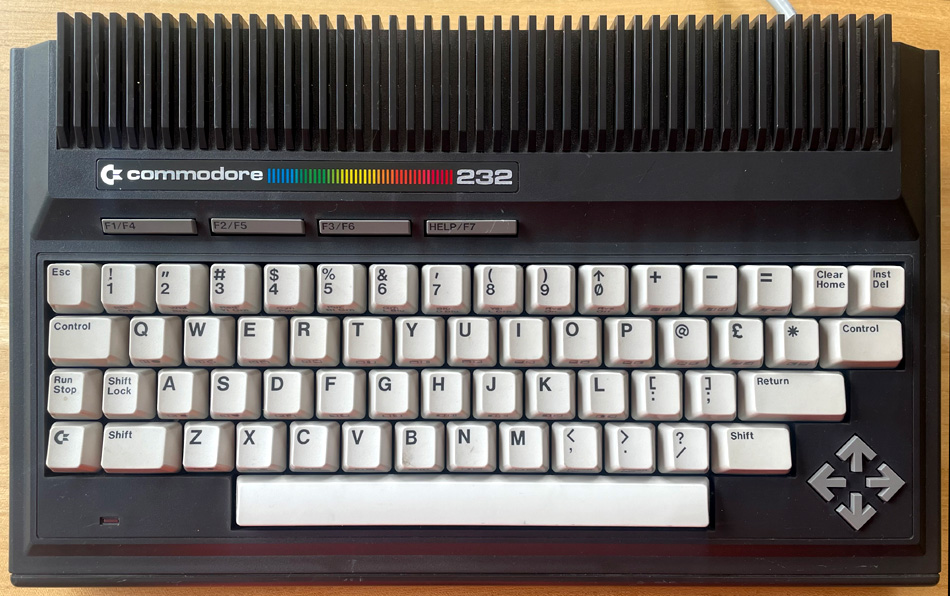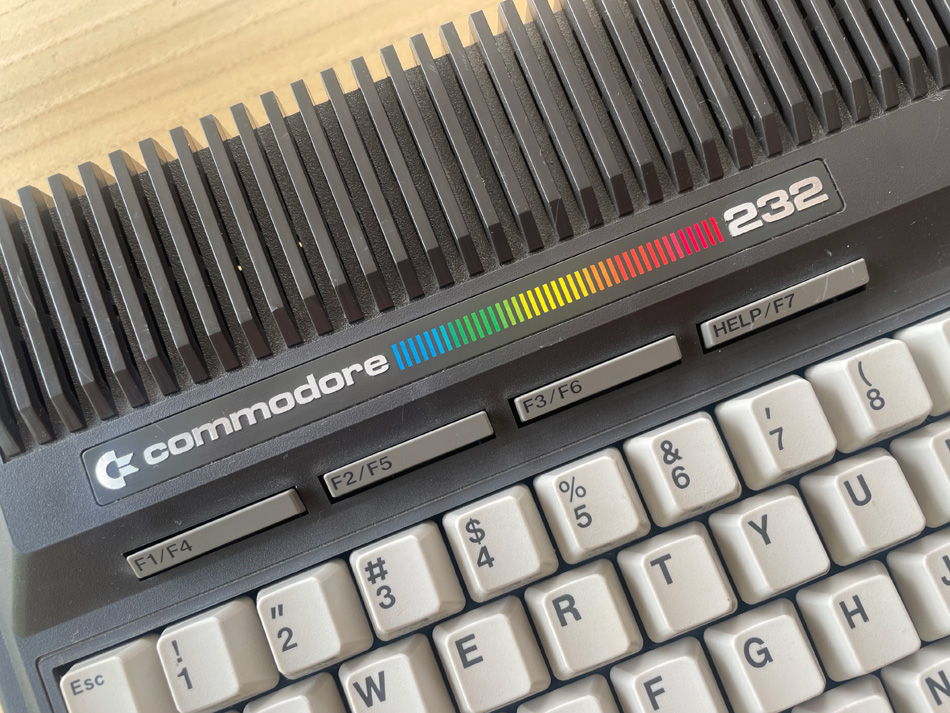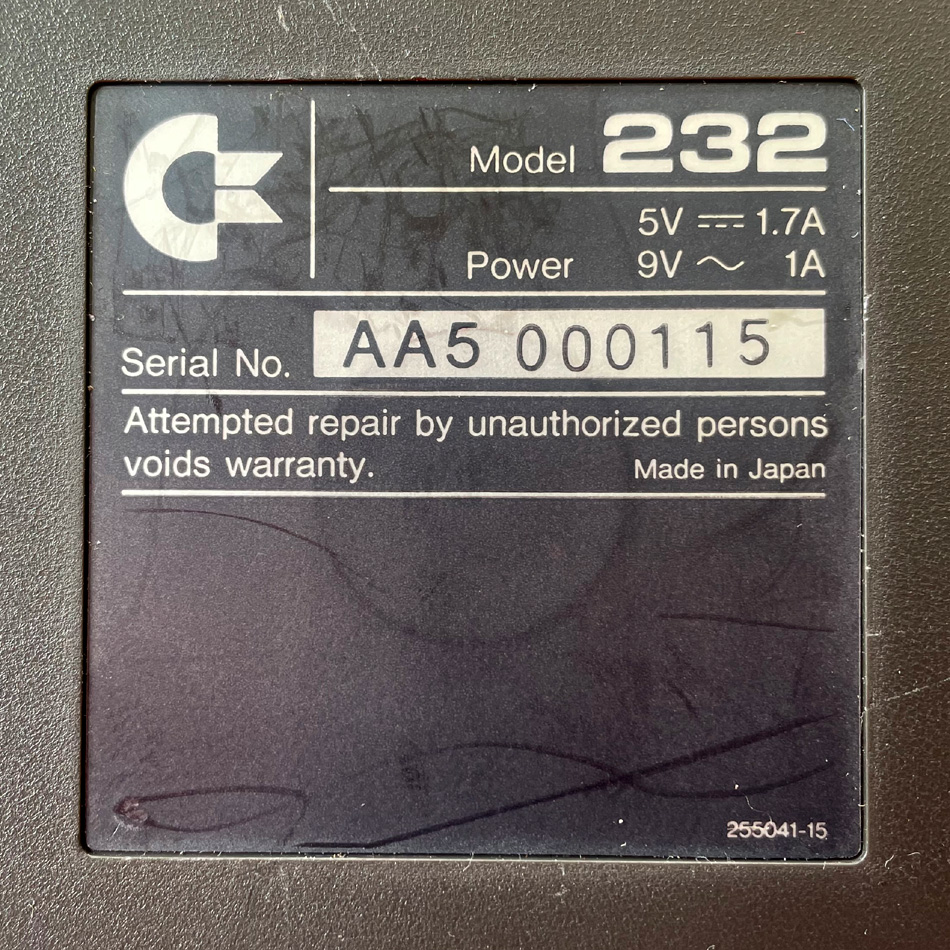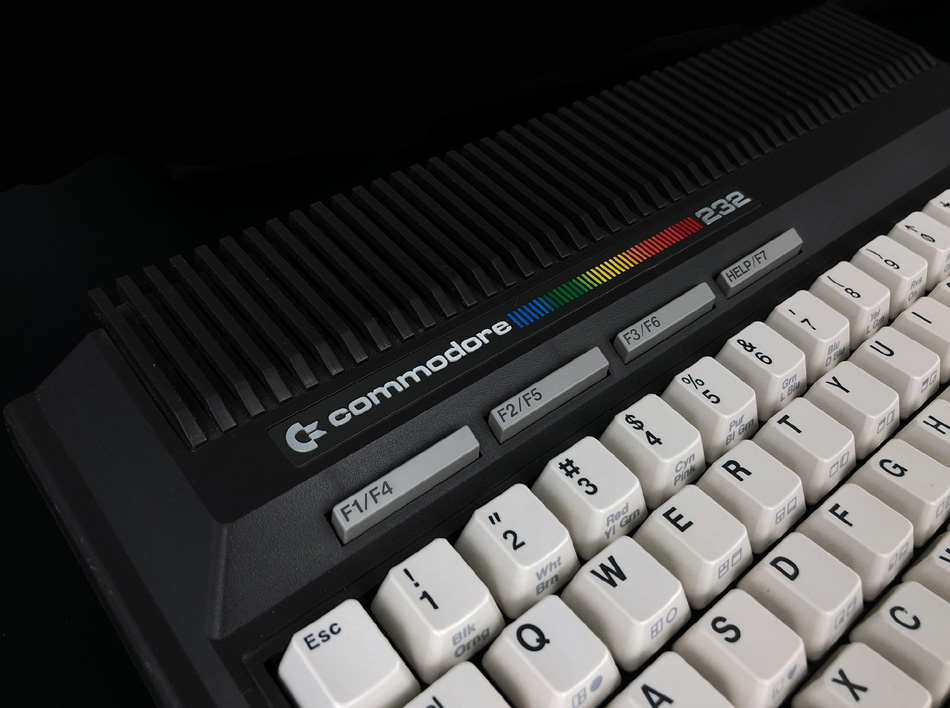|  Description Description | Prologue
This is what crock has written about the fully working 232 model he acquired (000108), which is the same in the following pictures. Larger versions and more pictures here.
---
History of the machine
I acquired this machine from a gentleman in Norway who used to work for a company that handled the Norwegian servicing for Commodore, somewhere near Oslo. The machine has its original plain white cardboard box with C232 hand written on the outside and “000108” stamped on the top. I know this is the original box as the 000108 matches the serial number on the underside of the case which is AA4 000108. According to the case, the machine was manufactured in Japan. The full contents of the label are:
C= Model 232
5V DC 1.7A, 9V AC 1A
Serial No. AA4 000108
Attempted repair by unauthorized persons voids warranty.
Made in Japan, 255041-14
This would appear to fit with the Commodore canon as my understanding is that once Bil Herd’s team finished the original design of the TED64, it was handed off to Commodore Japan to complete the production models prior to the June 1984 release date. The latest date appearing on any of the IC’s is week 10, 1984 placing the likely production date of the machine in mid March 1984. My assumption is that these pre-production machines were distributed to selected service centres and software development teams in preparation for the release.
Whether it was ever used in such a role is unclear, but I believe it was unlikely, for two reasons. First, repeated plugging in of connectors leaves small scratches on the plastic face of the female sockets. There is no visible signs of such on this machine. Second, and more telling, due to an assembly fault with the keyboard, the space bar was effectively stuck ‘down’ making the machine practically unusable. This would also seem to imply that the machine never underwent any burn-in testing as was customary for Commodore machines. So, I would surmise that shortly after manufacture in March 1984, it was shipped to Norway untested and has sat in it’s box pretty much untouched until I acquired it 27 years later.
Board Description
The PCB is exactly the same form factor as a Plus4 board. The Assy No is “250439” and the PCB number is “251728 Rev 3”, implying earlier versions existed. There is a typed paper serial number stuck on the bottom of the board with “000438” I think the serial number of 000438 is unlikely to represent the 232 board or more of them would have been found in the wild. I am also lucky enough to own a pre-production C16 board made within a few weeks of this one that has an identical format label with the number “000361” leading me to speculate that this serial number could refer to all pre-production 264 series boards coming from Japan.
Visually and layout wise the board closely resembles that of the Plus 4, but architecturally it is closer to that of the C16 / C116. Missing are the 6551/8551 ACAI RS232 chip and the additional 6529 to handle the user port, as is the user port itself. As the power supply is via the square 4 pin din, the power components are the same as the Plus 4, albeit spread out a little more. As there is no user port on the 232, the only purpose of the 9V AC supply is to power the cassette motor. Other than the user port, the other connectors are in exactly the same positions as they would have been found on a Plus 4.
Also present on the board are sockets to take the option ROM’s. Although I haven’t tried it, I would assume that the option ROM’s from a plus 4 would work. However, I have no idea whether the built in software is aware of the possibility of only having 32k of RAM.
Unlike the Plus 4 J8 and J9 do not exist, which control whether the cassette sense is implemented by P7 of the CPU or by D2 on locations $FD10 - $FD1F. The 232 uses the same pattern as the C116, where the cassette sense drives a buffer on the D2 line (U11 – 74LS125) enabled by the PLA on access to $FD1x addresses. There appears to be some hand reworking of the board to ensure that the cassette sense is pulled logic high if unconnected. This same reworking appears slightly differently on my pre production C16 board as well.
The biggest unique feature of this board which sets it apart from any of the other 264 machines is the implementation of the RAM subsystem. The original TED design was based around a 64k system implemented using 8 64kx1 bit DRAM’s, as you see in the Plus 4 which keeps the architecture relatively simple using one DRAM for each bit. With the pressures of DRAM pricing, the C116 and C16 were implemented using 2 16kx4 bit DRAM’s which again is architecturally straightforward, with each DRAM fully implementing 4 bits each.
So how then would you implement a 32k architecture? My understanding is that due to the architecture of early DRAM’s and the multiplexing of the address lines, typical DRAM sizes of the time went up in multiples of 4, hence no commonly available 32k DRAM’s . Whatever the reason, Commodore implemented the RAM using 4 16kx4bit DRAM’s, the same chips as appear in the C16 and C116. However, this means that A14 now has to control which pair of DRAM’s are selected for RAM reads and writes, requiring an extra d-type flipflop (74ls74) and a pair of or gates (74ls32.)
I am no digital circuit expert but from my analysis of the board, A14 is used to latch the complementary outputs of the flipflop using /RAS which are then used in conjunction with the TED /CAS signal to drive /CAS on the DRAM’s, with two on each of the flipflop outputs.
Final words
A plus 4 with 32k ram, no option software (so not really a plus anything), and no user port. Like I said in my original post, common sense should have killed this machine off before it got anywhere near a prototype stage.
It was never a production machine, just a handful of pre-production machines like this one. In total there is reference to 3 or 4 on various collectors websites.
I like it just because it's an oddity, it's in mint condition and it works!
Martin from Holland adds...
Regarding "only a handful were made" statement above: as I recall, pallet full of these units where sold at the "HCC Dagen". HCC Dagen was the biggest computer fair in Holland for years. (HCC = Hobby Computer Club, Dagen = Days.) Brokers selling left over computers and parts. In the early days of computing, big companies waited until the HCC Dagen to announce new products. This was around 89/90, and a friend and I did buy them. My one was later sold to a C16 & Plus/4 fan/collector.
|
| |
|  Commodore 232 AA5 000115 Front View Commodore 232 AA5 000115 Front View |  |
| |
|  Commodore 232 AA5 000115 Logo Commodore 232 AA5 000115 Logo |  |
| |
|  Commodore 232 AA5 000115 Serial Commodore 232 AA5 000115 Serial |  |
| |
|  Dave McMurtrie's Commodore 232 Logo Dave McMurtrie's Commodore 232 Logo |  |
| |
|  Dave McMurtrie's Commodore 232 Serial Dave McMurtrie's Commodore 232 Serial |  |
| |
Copyright © Plus/4 World Team, 2001-2025. Support Plus/4 World on Patreon |